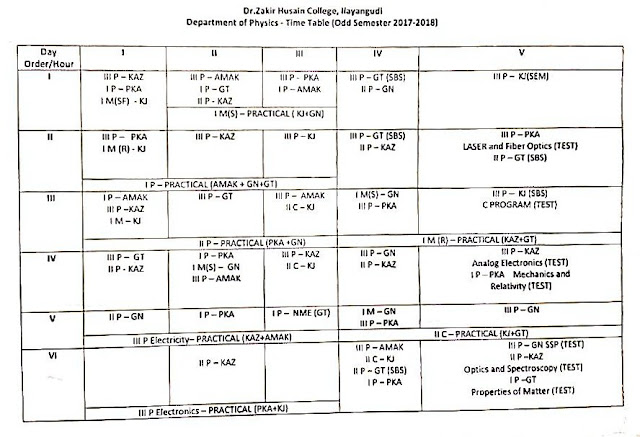Analog Electronics Syllabus - 4BPH5C1
III YEAR – V SEMESTER
COURSE CODE: 4BPH5C1
CORE COURSE IX – ANALOG ELECTRONICS
Unit I SEMICONDUCTOR DIODES AND REGULATED POWER SUPPLIES
Semiconductor diode – Crystal diode – Rectifiers – Half and full – Wave rectifiers – Bridge rectifier– Efficiency – Ripple factor – Filter circuits.
Zener diode – characteristics – Voltage regulator – Regulated power supply – Problems.
Unit II TRANSISTORS AND TRANSISTOR BIASING
Transistor action – CB, CE & CC modes – Comparison – Amplifier in CE arrangement – Load line analysis – Cut – off and Saturation – Power rating – Application of CB amplifier.
Transistor biasing – Various methods of transistor biasing: base resistor, feedback resistor, voltage divider methods – Hybrid parameters – Determination of h parameters – Analysis of a transistor CE amplifier using h parameters.
Unit III AMPLIFIERS – SINGLE STAGE & MULTISTAGE
Single stage amplifier – Phase reversal – DC & AC equivalent circuits – Load line analysis – Voltage gain – Classification of amplifiers – Input impedance of an amplifier.
Multistage transistor amplifier – RC, transformer, direct coupled amplifiers – Comparison of different types of amplifiers.
Unit IV AUDIO AMPLIFIERS AND OSCILLATORS
Transistor audio power amplifier – Difference between voltage and power amplifiers – Performance quantities of power amplifiers – Classification of power amplifiers – Expression for collector efficiency – Class A amplifier – Push – Pull amplifier – Heat sink.
Feedback principle – Negative and positive feedback – Current gain with negative feedback – Emitter follower – DC analysis – Types of oscillations – Undamped oscillations – Colpitt, Hartley, Phaseshift Oscillator.
Unit V OP AMPS
OP AMP: characteristics, OP AMP biasing – Non – inverting & Inverting amplifiers – Applications of OPAMP – adder, subtractor, differentiator, integrator – waveforms study, scale changer and sign changer – Instrumentation amplifier – Voltage level detector.
OP AMP signal generators: Phase shift, Colpitts', Hartley, Square wave and triangular wave generators.
Books for Study
1. V.K.Mehta, Principles of Electronics, S.Chand & Co Ltd.,10th Edition 2007.
2. R.S.Sedha – Text Book of Applied Electronics, S.Chand & Co Ltd., II Edition 2004.
Books for Reference
1. B.L. Theraja – Basic Electronics – S. Chand & Co, V Edition 2009.
2. Malvino & Leach – Transistor Approximations – International Publication – 2000.
Optics And Spectroscopy Syllabus - 4BPH3C1
II YEAR – III SEMESTER
COURSE CODE: 4BPH3C1
CORE COURSE VI – OPTICS AND SPECTROSCOPY
Unit I GEOMETRICAL OPTICS
Lens – Spherical aberration in lenses – Methods of minimizing spherical aberration – chromatic aberration in lenses – condition for achromatism of two thin lenses (in and out of contact) – Coma –– Aplanatic lens –– Eyepieces – Ramsden’s and Huygens’s eyepieces.
Dispersion – Angular and Chromatic dispersion – combination of prisms to produce i)dispersion without deviation ii) deviation without dispersion – Cauchy’s dispersion formula– Direct vision spectroscope – Constant deviation spectroscope.
Unit II INTERFERENCE
Conditions for interference – colours of thin films – Air wedge – theory – determination of diameter of a thin wire by Air wedge – test for optical flatness – Newton’s rings – Determination of refractive index of a liquid.
Michelson’s Interferometer – theory and its Application (Measurement of wavelength and difference between wavelength of two close lines, thickness of mica sheet, standardization of meter) – Jamin’s and Raleigh’s interferometers – determination of refractive index of gases
Unit III DIFFRACTION
Fresnel’s diffraction – diffraction at circular aperture – opaque circular disc, Straight edge and narrow wire – Fraunhofer Diffraction at single slit – Double slit – Plane diffraction grating – theory and experiment to determine wavelength – overlapping of spectral lines.
Rayleigh’s criterion for resolution – resolving power – resolving power of grating – resolving power of a prism.
Unit IV POLARISATION
Double refraction – Huygens’s explanation of double refraction in uni axial crystals – Nicol Prism – Nicol Prism as polarizer and analyzer – Polaroids and their uses – Quarter wave plates and Half wave plates.
Plane, elliptically and circularly polarized light – Production and detection – Optical activity– Fresnel’s explanation of optical activity – Specific rotatory power – determination using Laurent’s half shade polarimeter.
Unit V SPECTROSCOPY
Microwave and infrared Spectroscopy – Rotation of molecules – Rotational Spectra – The rigid diatomic molecules, selection rules – the intensities of spectral lines – techniques and instrumentation (outlines only) Infrared spectroscopy (outlines only) – FTIR (outlines only).
Raman Spectroscopy – Quantum theory of Raman effect – Classical theory of Raman effect – Molecular Polarisability – pure rotational Raman spectra of linear molecules – vibrational Raman spectra – Applications – techniques and instrumentations (outlines only).
Books for Study
1. Optics and Spectroscopy – R.Murugeshan, S. Chand and co., New Delhi, 6th Edition 2008.
2. A text book of Optics – Subramanyam and Brijlal, S. Chand and co.. New Delhi, 22nd Edition 2004.
3. Optics – Sathyaprakash, Ratan Prakashan Mandhir, New Delhi, VIIth Edition 1990.
4. Introduction to Molecular Spectroscopy – C.N.Banewell, TMH publishing co. New Delhi,IV Edition 2006.
5. Elements of Spectroscopy – S.L. Gupta, V.Kumar and R.C.Sharma – Pragati Prakashan, Meerut, 13th Edition 1997
6. Molecular structure and spectroscopy – G.Aruldhass, PHI Pvt Ltd, New Delhi, II Edition 2007.
Subscribe to:
Posts (Atom)
